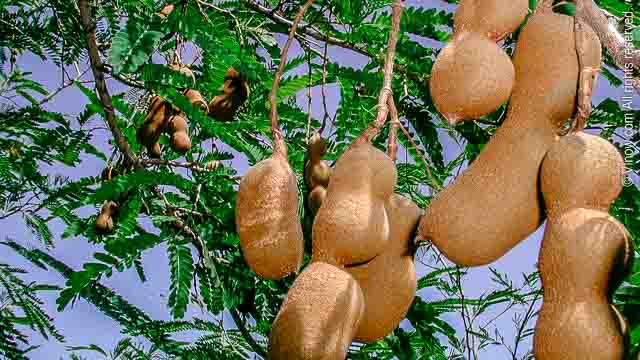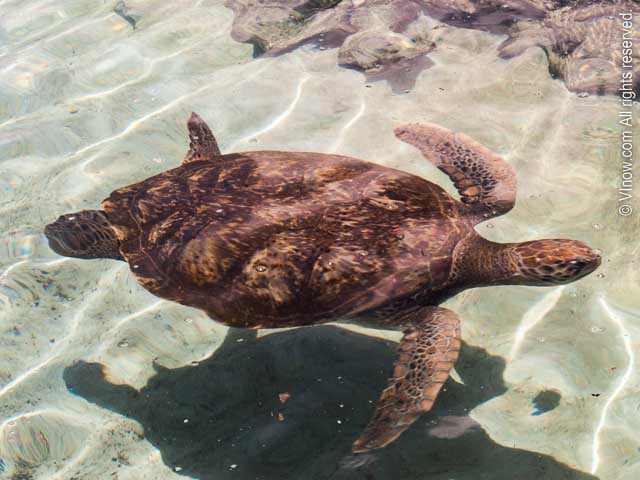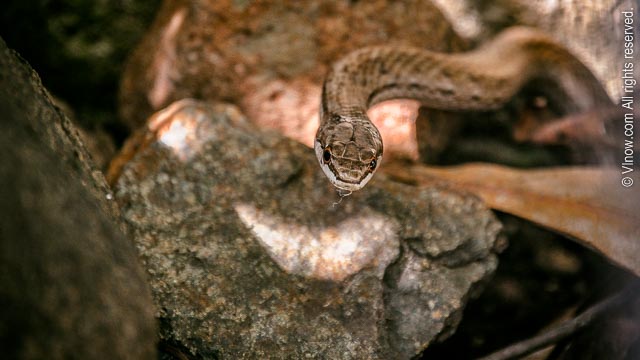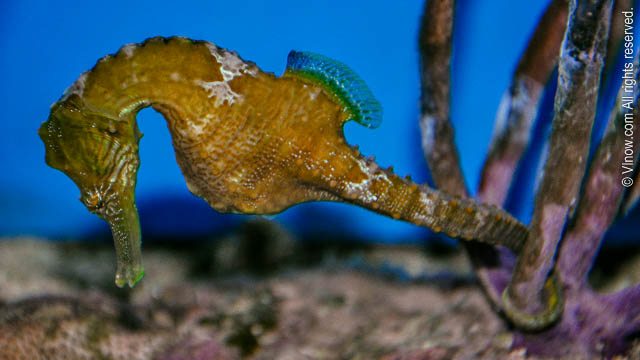A few years ago while visiting Estate Whim Plantation on St. Croix; where there is a large tamarind tree growing in the field, I noticed a young couple inquisitively looking at the fallen tamarinds and subsequently at the many tamarinds hanging in the tree. I could hear them talking. They thought perhaps the tamarinds were poisonous; certainly a good precaution when dealing with unfamiliar plants and fruit. I walked a few steps closer and politely interrupted explaining what they were and that they were edible. I had already picked several so I took one, cracked it open and ate a piece. The couple looked on fearfully. Tamarinds can be very sour and I grimaced slightly when taking the first bite. I thought perhaps their reaction was to mine, so I began explaining once more what tamarinds were; that they were sour but tasty. I suggested they try one. They declined. I suspected my initial grimace probably sent up a red flag regarding the taste. But they really are good, really!
The Fruit
Young tamarind fruit are green and tender with soft whitish under-developed seeds. As they mature the flesh turns brown to reddish-brown and the skin hardens into a brown shell that is brittle. Mature fruit look like a beanlike pod; the pod has bulged areas and a slight curve. Inside is a soft pulp around hard seeds. A few strands of fiber extend from the stalk around the pulp covered seeds. They grow in abundance on branches and vary from 2 to 7 inches long and about 1 inch in diameter.
The Tree
Tamarind trees grow in tropical areas around the world. In the Caribbean it is widely distributed. It is a slow growing tree, long living and hardy. It can grow up to 80 feet in height. Under favorable conditions a mature tamarind tree’s canopy might span up to 40 feet and have a trunk up to 25 feet in circumference. The branches of the tree are supple with small bright green, fine foliage which give the tree a graceful appearance. Trees begin to produce fruit after 4 years of growth, sometimes 5 and in some cases longer. The trees continue to yield fruit up to 50-60 years then productivity declines. The tree however can live another 150+ years. A few of the largest tamarind trees in the U.S. Virgin Islands are thought to be 300+ years old.
Uses
Tamarind trees and the fruit have a wide range of uses. In the U.S. Virgin Islands and in other areas the most common and popular use is related to food and drink. Both mature and green tamarinds are eaten. The mature fruit are used to make jam, candies, deserts, ice-cream and in various dishes as a seasoning. Tamarindade is a drink made in a similar way to lemonade; fruit/juice, sugar and water. Some recipes include adding cinnamon and other spices. Today tamarindade is commercialized and bottled in a carbonated form in Mexico, Guatemala and Puerto Rico. The wood is sometimes used to make furniture and wood flooring. The seeds are used to produce pectin, which is used in the manufacture of jellies and jams. The leaves and fruit are used for various medical applications. The leaves have also been used in dying processes and fruit mixtures for cleaning silver and cooper.
Trying Tamarinds
While visiting the U.S. Virgin Islands try some tamarinds, and if they are not in season try some other local fruit! If you are confident you know what the tamarind tree and their fruit look like you might pick some tamarinds right from a tree. Often there are some fallen beneath the tree. If you pick one up from the ground make sure the shell is not cracked. Inside the pulp should be a light smooth brownish color. If it is not even colored or looks moldy throw it out and pick another. If in doubt, you can purchase some from a roadside vendor. Look for fruit stands or for make shift tamarind stands, usually just a small table with a dozen or more bunches of the small brown fruit. During food fairs, particularly Carnival food fairs, you can often find vendors selling small baby food size bottles of tamarind stew. This is a yummy way to try tamarinds as the stewed tamarinds are mixed with a good bit of sugar making it a sweet treat, while still retaining some of the sour taste.
How to Eat a Tamarind
The mature tamarinds have brittle shells. Applying gentle pressure will cause the shell to crack. Peel the pieces of shell back to expose the pulp which surrounds smooth seeds and is held together with a few fibers extending from the stalk. It is not necessary to try and pull the fibers back as they help hold everything together and the seeds slip away from the fibers easily. The fruit has multiple small bulges, each bulge is a seed. Bite down just after the first seed and pull away. Be ready for the sour taste! Scrape the pulp off the seed with your teeth and spit the seed out.
Local Superstition & Beliefs
A large tamarind tree provides ample shade beneath its branches. As would be expected it is cooler in the shade. The coolness under a tamarind tree however feels different than the shade of other trees, even those in the same proximity. The tamarind tree produces ‘a natural air conditioning’. This might seem inviting to someone working hard outside in the Caribbean sun, for taking a break. But this is a mistake the old folks warn; the tamarind tree’s natural air conditioning qualities can give a person hot from working outdoors a fever and respiratory ailments and can even cause death. So the story goes at least. Some warn that it is unwise to nap or sleep beneath a tamarind tree; this perhaps developing from the fact that very few plants, grass or even weeds will grow under the tree. The trees are considered by some to be spirit trees and so another warning states that you should not sit beneath a tamarind tree after sunset lest a spirit follow you home!
Island Talk
In the U.S. Virgin Islands the tamarind tree is called ‘tamon’ tree; pronounced tah-mon. The same is used for the fruit.







